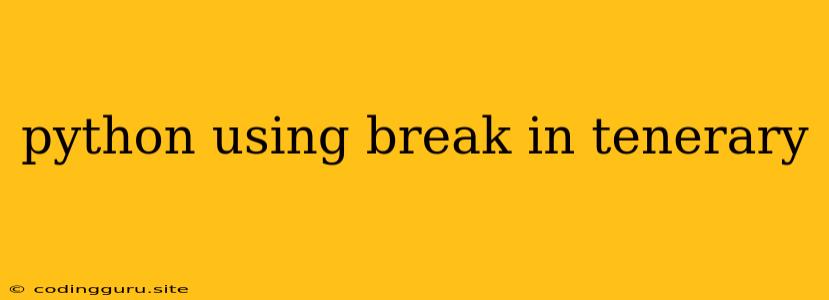Python Using break in Ternary Operators: Can You Do It?
The ternary operator in Python is a concise way to write conditional expressions. It's a powerful tool for making your code more compact and readable. However, you might wonder if you can directly use the break statement within a ternary operator. The answer, unfortunately, is no.
Let's delve into why this is the case and explore alternative ways to achieve similar results.
Understanding the Python Ternary Operator
The ternary operator in Python has the following structure:
[on_true] if [condition] else [on_false]
The condition is evaluated. If it's True, the on_true expression is executed. If it's False, the on_false expression is executed. The entire expression returns the result of the chosen expression.
Example:
result = "Even" if number % 2 == 0 else "Odd"
In this example, if number is divisible by 2, result will be assigned the string "Even". Otherwise, it will be assigned "Odd".
Why break Doesn't Work in Ternary Operators
The break statement is used to exit loops (e.g., for loops, while loops). It's not designed to control conditional expressions. Ternary operators, on the other hand, are for evaluating and returning a single value. They don't directly manage the flow of execution within loops.
Alternatives to break in Ternary Operators
While you can't directly use break within a ternary operator, there are effective alternatives to achieve similar logic:
1. Using if and else Blocks:
If you need more complex logic than a simple ternary operator can handle, consider using standard if and else statements. This provides you with greater flexibility and control.
Example:
for number in range(1, 11):
if number == 5:
break # Exit the loop when number is 5
else:
print(number)
2. Returning Values to Control Loop Flow:
Instead of using break, you can structure your code to return a specific value from your function or method. This value can be used in the calling loop to control its execution.
Example:
def get_next_value(current_value):
if current_value == 5:
return None # Signal to stop
else:
return current_value + 1
current_value = 1
while True:
next_value = get_next_value(current_value)
if next_value is None:
break # Exit the loop when get_next_value returns None
else:
print(next_value)
current_value = next_value
3. Conditional Functions or Methods:
You can encapsulate your logic within functions or methods that return different values based on conditions. This promotes modularity and code readability.
Example:
def get_value(condition):
if condition:
return "Value A"
else:
return "Value B"
for i in range(1, 11):
if i == 5:
result = get_value(True)
print(result) # Will print "Value A"
break
else:
result = get_value(False)
print(result) # Will print "Value B"
4. Lambda Expressions:
Lambda expressions can be used to create anonymous functions, which can be used within ternary operators to achieve conditional logic.
Example:
check_condition = lambda x: "Condition Met" if x > 5 else "Condition Not Met"
for i in range(1, 11):
result = check_condition(i)
print(result)
if result == "Condition Met":
break
Conclusion
While you can't directly use break within a ternary operator in Python, the alternatives provide powerful and flexible ways to control loop flow and achieve your desired outcomes. Choose the approach that best suits your specific code structure and logic requirements.
